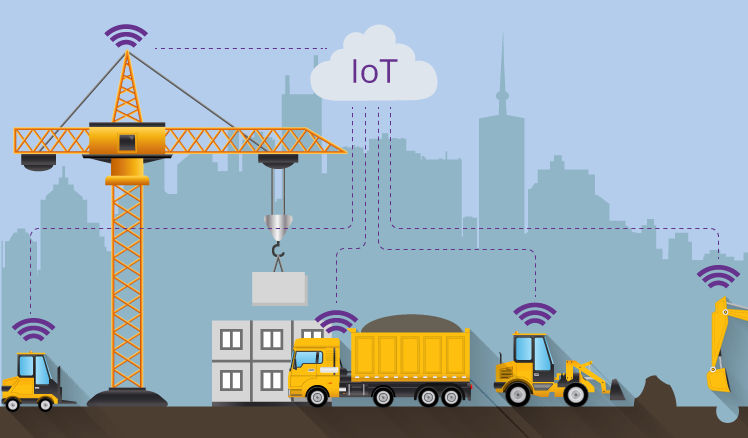Cutting back construction costs and delays with IoT
Reducing costs and time to complete projects and not to compromise on their quality is a constant challenge in the construction industry. While this is a goal in nearly every sector, construction faces particular difficulty with it. According to the research from McKinsey, large construction projects typically last 20% longer than scheduled and cost 80% more than expected.
The sector is increasingly turning to technology (for example, the Internet of Things, or IoT) to address these challenges.
IoT in construction

IoT is a network of devices connected to the internet. Virtually any device that can be equipped with sensors and transmit data to the internet can become a part of IoT. On a construction site, the examples are machinery, vehicles, consumables, and devices worn by employees.
IoT can support data collection about a variety of processes and pieces of equipment involved in a project as well as connect an entire construction site — and even multiple sites — via the internet.
Here are the ways construction site managers can use IoT solutions to reduce construction costs and increase the efficiency of work.
Preventive maintenance
It costs less to perform regular maintenance on equipment than to fix components after they break. Unexpected equipment failure can also lead to the downtime that can extend the timeframe of a project.
Equipping assets with IoT sensors can help managers determine when to conduct preventive maintenance to optimize performance and avoid breakdowns.
Sensors can track such indicators as excessive vibration, temperature fluctuations, and more. They also can help identify the need to check on a machine’s engine or replace its air filter. The IoT system can then send a warning to maintenance workers’ smartphone, tablet or computer, so they can fix the problem before it causes significant complications.
Improved fuel efficiency
Fuel can make up as much as 50 percent of a machine’s operating expenses, so using it efficiently can significantly reduce costs for any project.
IoT devices can track a machine’s fuel usage and its idle time. Using this data to reduce the time a machine spends unproductive can prevent you from wasting fuel and money.
Asset tracking
Using GPS and IoT technology, construction professionals can track all the assets on a worksite, including machinery, vehicles, consumables, and so on.
This knowledge can help ensure that everything is in the right place at the right time and reduce the amount of time spent waiting while supplies are gathered or transferred from other sites. It also helps prevent theft and loss of assets. IoT can also help keep track of how much consumables are left at a location, giving managers the time to order more when needed.
Enhanced safety
Keeping equipment adequately maintained reduces the likelihood of accidents. Construction sites can also incorporate sensors that detect potentially dangerous conditions (for example, chemical leaks) and warn employees.
Smart wearables can also track worker data and warn them of approaching hazards. For example, Spot-R clips can detect workers’ falls, injuries, and fatigue, as well as alert project managers about emergencies. Smart Cap headwear can measure fatigue and micro-sleeps to ensure workers’ health and focus.
Remote management of worksites
With IoT tech, construction site supervisors can monitor their worksites from anywhere and get meaningful insights into working processes based on the collected data. This can be especially helpful for supervisors who are in charge of multiple locations and dispersed workforce. For example, smart glasses can help walk workers through complex tasks. The glasses record what a worker sees and send this data to an IoT system and to a specialist who can give real-time feedback and instructions.
In conclusion
IoT starts to have a substantial influence on the construction industry. Equipping construction site assets with IoT sensors helps to reduce costs due to the possibility of preventive maintenance, increase the efficiency of works by tracking assets and optimizing fuel usage. Moreover, it is easier to perform the overall management of worksites and enhance workers’ safety with the assistance of IoT.


